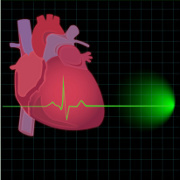 Photo: Getty Images
Photo: Getty Images
Just as surely as November and December are considered the winter holiday season, so January must certainly be the season of resolutions. While resolutions can take on many shapes and forms, diet and exercise frequently appear on the resolution top 10 list.
If you’re concerned about your heart health, then increasing your levels of physical activity is a win when it comes to resolutions.
Let’s face it. We are the supersize-me-couch-potato-computer-screen digital generation. Most of us spend more time in sitting in front of the computer screen, behind the wheel of a car, or in front of the television than we do exercising, walking, biking, or engaging in any type of physical activity.
As a result, the vast majority of American adults – 65 percent – are either overweight or obese. Not only are we adults supersized, but our children are rapidly joining us.
Lack of physical exercise, along with obesity, is one of the major risk factors for heart disease, stroke, high blood pressure, and diabetes. When it comes to your health, one health problem often leads to another.
Such is the case with heart disease since stroke, high blood pressure, and diabetes are also independent risk factors contributing to heart disease as well. Many of these risk factors can reduced or eliminated, and overall and heart health improved, simply by getting up and moving.
It sounds simple doesn’t it? Just get up and get moving. In actuality, getting fit and improving your heart and overall health may be easier to say than do.
The reality is that it’s harder to make time in our schedules for regular physical exercise than ever before. Between fewer jobs that require physical activity, an increase in the average work week, poor diets, and higher stress levels, finding time to exercise regularly will take real commitment.
The American Heart Association recommends 30 minutes of activity daily. Since time is a precious commodity for most of us, it’s important to make the most of your exercise routine.
One way to make certain that your heart is getting the perfect workout is to check your target heart rate. Target heart rate is a way to ensure that your heart is working hard enough, without overworking.
To calculate your target heart rate, first determine your resting heart rate. Resting heart is the number of times your heart beats in a minute while you are resting. While resting heart rate can be affected by age or certain medications, for most of us the resting heart rate will be somewhere between 60 and 80 beats per minutes.
Resting heart rate can be determined by placing the tips of your first two fingers on your wrist where it’s easy to feel the blood vessels. Hold for 10 seconds and then multiply by 6.
For example, if your heart beats 11 times in 10 seconds, you would multiply 11 times 6 for a resting heart rate of 66 beats per minute. Your target heart rate when exercising should be between 50 to 85 percent of the resting heart rate. So, if your resting heart rate is 66 beats per minute, your target heart rate when exercising should remain between 99 and 122 beats per minute.
While adding regular exercise to your daily routine may seem daunting at first, you can break exercise up into 10 minutes segments. In addition to improving your heart health and helping you manage your weight and blood pressure, you’ll find numerous other benefits to adding physical exercise to your life including strengthening your immune system, improving mental well-being, increasing strength, stamina and energy, limit bone loss, delay or prevent chronic conditions associated with aging and much, much more.
For women, exercise can be particularly beneficial to heart health. Adding the recommended 30 minutes of daily exercise may reduce a woman’s risk of heart disease by as much as 40 percent! With so many wonderful benefits, why not add improving your heart health by adding physical activity to your list of New Year’s resolutions?
Sources:
Target Heart Rates. American Heart Association. 30 Nov 2011. http://www.heart.org/HEARTORG/GettingHealthy/PhysicalActivity/Target-Heart-Rates_UCM_434341_Article.jsp#.TwpNjtVEaSo
The Price of Inactivity. American Heart Association. 19 Jan 2011. http://www.heart.org/HEARTORG/GettingHealthy/PhysicalActivity/StartWalking/The-Price-of-Inactivity_UCM_307974_Article.jsp#.TwpQqdVEaSo
Physical Activity Improves Quality of Life. American Heart Association. 26 Jan 2011. http://www.heart.org/HEARTORG/GettingHealthy/PhysicalActivity/StartWalking/Physical-activity-improves-quality-of-life_UCM_307977_Article.jsp#.TwpRA9VEaSp
Reviewed January 10, 2012
by Michele Blacksberg RN
Edited by Jody Smith





Add a CommentComments
There are no comments yet. Be the first one and get the conversation started!